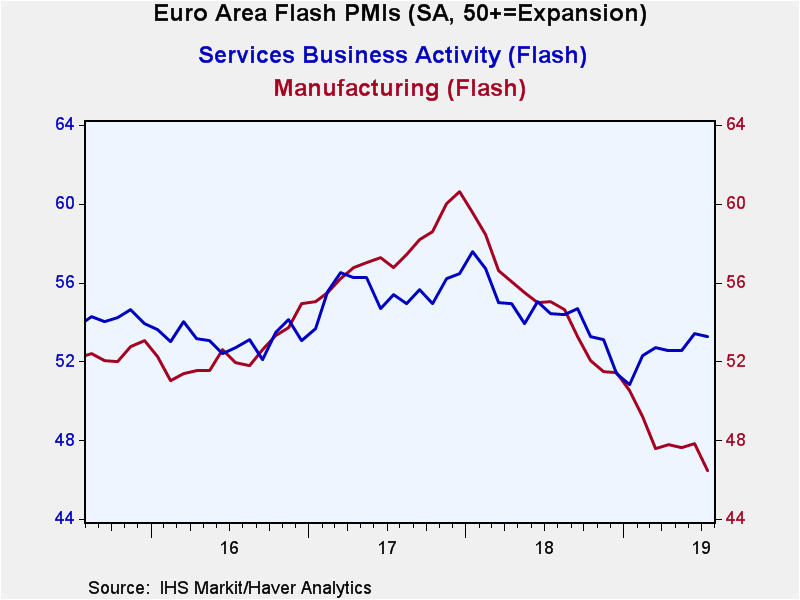 Global| Jul 24 2019
Global| Jul 24 2019EMU 'Flash' PMIs Show Deepening Manufacturing Weakness
Summary
In manufacturing growth is hanging on by its fingernails or has already lost its purchase to decline. Private sector PMI raw diffusion gauges are below the value of 52 across the board. Ranked on data back to January 2015, the HIGHEST [...]
 In manufacturing growth is hanging on by its fingernails or has already lost its purchase to decline. Private sector PMI raw diffusion gauges are below the value of 52 across the board. Ranked on data back to January 2015, the HIGHEST standing of any private sector PMI in this table is France with a 39th percentile standing. Note that the PMI median on ranked standings occurs at a ranking of 50. All of these readings for the composite and for manufacturing reside below their, respective, median readings. Services have above median standings only in Germany and Japan.
In manufacturing growth is hanging on by its fingernails or has already lost its purchase to decline. Private sector PMI raw diffusion gauges are below the value of 52 across the board. Ranked on data back to January 2015, the HIGHEST standing of any private sector PMI in this table is France with a 39th percentile standing. Note that the PMI median on ranked standings occurs at a ranking of 50. All of these readings for the composite and for manufacturing reside below their, respective, median readings. Services have above median standings only in Germany and Japan.
The U.S., Germany and EMU overall have their respective lowest manufacturing rank standings since January 2015. Moreover, the German manufacturing reading has fallen very sharply this month. After this substantial period of weakness over the past 54 months, the drop in the German manufacturing PMI is the third largest in those 54 months with the larger declines coming within the past year in September 2018 and March 2019.
Bucking the trend to further weakness overall is the services sector which is either holding its ground or advancing in most countries and economic units (EMU) in the table in July. The service sector PMI is higher in July in the U.S. and Japan by substantial amounts, but service are only marginally weaker-essentially unchanged in the EMU and Germany. The services sector took a clear step lower in France.
The sequential readings on 12-month, six-months and three-month readings generally show deterioration. The U.S. shows ongoing deterioration for manufacturing and services on this timeline. For Japan, manufacturing has the same deterioration with a very minor improving trend for services. France shows manufacturing deterioration sequentially with French services in a slight improving reversal over three months. Germany shows manufacturing deterioration sequentially with a services rebound over three months. The EMU echoes the German situation.
The emerging picture shows a worrisome step in manufacturing weakness that is still severe and relatively broad. The services sector demonstrates some minor strength, but it still is notable that services have been able to gain purchase at a time that manufacturing is under increasing pressure.
The slight uptrend in the services readings are a sharp counterpoint to the weakness in manufacturing. But the service sector gradient is slight compared to the sharp downtrend in manufacturing. In fact, the services sector also can be interpreted as making a hard rebound from its deepest cycle low point that puts the uptrend interpretation on thinner ice. On balance, the new flash PMI data released today do not reassure us that conditions of weakness are damping down but instead show that forces of weakness are still gathering momentum and are concentrated in manufacturing and likely linked to global trade tensions.
Robert Brusca
AuthorMore in Author Profile »Robert A. Brusca is Chief Economist of Fact and Opinion Economics, a consulting firm he founded in Manhattan. He has been an economist on Wall Street for over 25 years. He has visited central banking and large institutional clients in over 30 countries in his career as an economist. Mr. Brusca was a Divisional Research Chief at the Federal Reserve Bank of NY (Chief of the International Financial markets Division), a Fed Watcher at Irving Trust and Chief Economist at Nikko Securities International. He is widely quoted and appears in various media. Mr. Brusca holds an MA and Ph.D. in economics from Michigan State University and a BA in Economics from the University of Michigan. His research pursues his strong interests in non aligned policy economics as well as international economics. FAO Economics’ research targets investors to assist them in making better investment decisions in stocks, bonds and in a variety of international assets. The company does not manage money and has no conflicts in giving economic advice.






